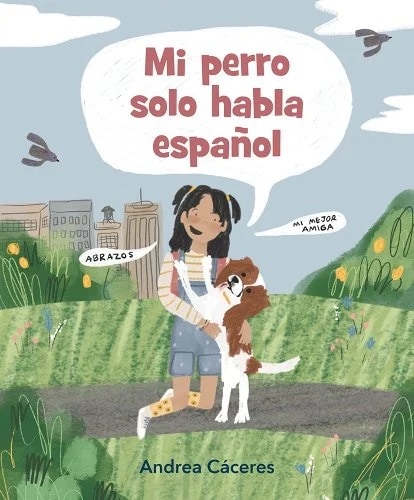Book Review: Mi perro solo habla español
This post may contain affiliate links.
Books carry the most weight and power when their readers can see themselves reflected in their stories. This is especially true for young readers- when their personal stories mirror those they read, the opportunities for self-reflection are abundant and the teaching opportunities vast.
In this post, I’ll introduce you to a new bilingual book, and give you a few discussion questions to use as you read the book with your own bilingual children or students.
One of the biggest themes in bilingual picture books is immigration, which is often treated as a difficult journey for families, rather than a celebration of a new life and home. I love to find bilingual picture books that highlight the importance of bilingualism in creative new ways.
That’s why I love the newly published Mi perro solo habla español by Venezuelan author/illustrator Andrea Cáceres. Available in English and Spanish, this book is a neat way to teach kids about bilingualism and how important it can be to retain your home language in a new country.

Published by Candlewick Press, the publisher’s description is as follows:
“When Aurora came to the United States, she learned to speak English. But her spaniel, Nena, did not. Sweet Nena loves to give besos, and she knows only Spanish. She doesn’t know SIT, but she does know SIÉNTATE. She doesn’t know WAIT, but she does know ESPERA. And while TREAT doesn’t mean anything to Nena, she can certainly sniff out a POSTRE! At the park, Nena may not know what the other dog owners are saying, but she and Aurora will always understand each other just fine. Borrowing from her lived experience, Venezuelan-American author-illustrator Andrea Cáceres offers a gentle, charmingly illustrated ode to love that extends a hand–or a paw–to readers who may feel displaced or are learning a new language themselves.”
In this book, immigrant children who are learning a new language in a new country will see themselves reflected in the character of Aurora, a newly arrived immigrant who is assimilating to life in the United States. Her dog grounds her in her native language because she doesn’t know English yet. Her dog is also a testament to how far she has come in learning English in her new country.
As you read this book with your children at home or in school, you’ll want to consider the following discussion questions. Make sure to ask your children or students why they answered the question the way they did.
- How do you think Aurora feels when she first arrives in the United States from her home country?
- Do you think it was hard for Aurora to learn English?
- How old do you think Aurora is in the book?
- Where do you think Aurora lives?
- Do you think Nena will ever learn English?
- How do you think Nena feels being a monolingual dog? Do you think she feels left out?
- Why is it cool to be bilingual?
- Would you like to move to live in another country?
- Do you think the other people in the book who speak Spanish also have dogs that speak Spanish?
- At the end of the book, do you think both the dog and her owner are bilingual? Or does Nena just keep only speaking Spanish?
Once you have discussed the book, you may want to label some of the items in your house with bilingual sticky notes like Aurora does in the book. You never know, you might just learn some new words from your parents!
You can buy the book Mi perro solo habla español in both English and Spanish now on Bookshop.org.

Christa Jimenez
Welcome! I’m Christa, a Spanish teacher married to a handsome Costa Rican and mother of two bilingual daughters. We’ve spent over 25 years living in and traveling to Costa Rica with our daughters, and this website is my love letter to all things Costa Rica- and to bilingual parenting too. You can read my full story here. Thanks for stopping by!







